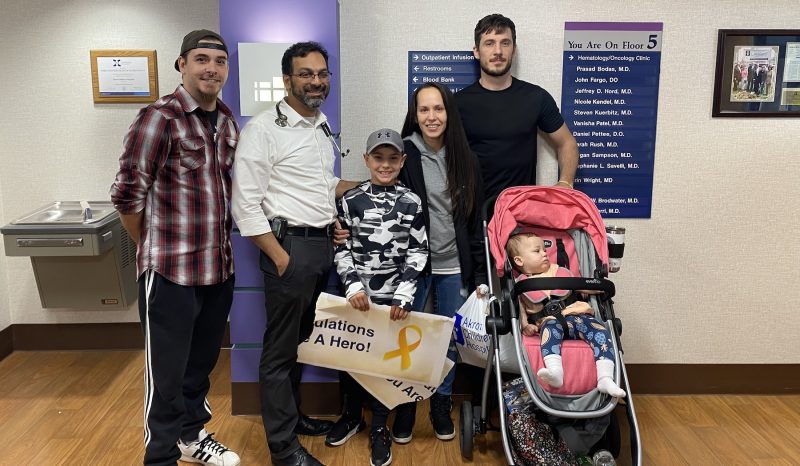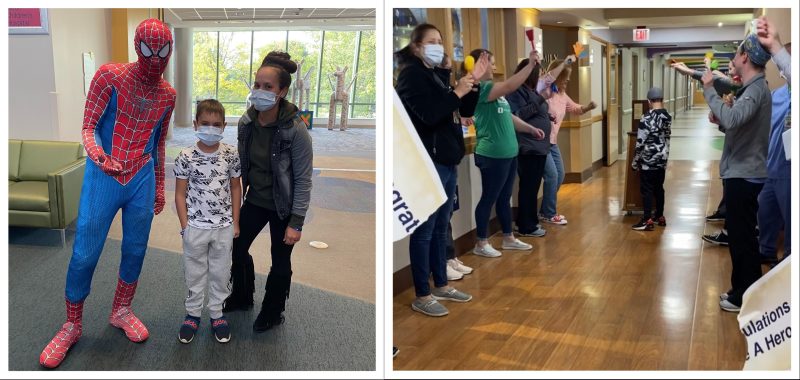
Julian (center) celebrates his victory over childhood leukemia with his mom (right), Dr. Bodas (left) and his family after ringing the cancer bell.
There’s nothing quite like the sweet sound of ringing victory bells — especially when they’re end of treatment bells that your son is ringing. It’s a sound that says he beat leukemia, he’s moving on and he can get back to childhood.
That’s how Julia felt watching her son, Julian, ring the bell a year ago this past spring. She watched in a mix of emotions, alongside Julian’s younger sister, his dad and all the oncology staff there to celebrate his victory. They rattled noise makers and played “Celebration” by Kool & The Gang, as Julian ran through the banner and rang the bell at the end of the hallway.
“It was an extremely happy moment and very emotional for all of us,” she said. “There were many tears of joy. Julian even teared up, too. We couldn’t believe we made it through almost 3 years of this tough cancer journey. We were like, ‘Wow, it’s done!’”
Getting a childhood leukemia diagnosis
Julian Uribe is an active kid. He’s a gray belt in jiujitsu and trains year-round, in addition to playing baseball and football. So, when Julia found a swollen, red spot on his upper thigh that looked like a bug bite after football practice, she thought nothing of it.
It wasn’t until Julian started having trouble walking that she grew concerned and took him to Akron Children’s Emergency Room. Through ultrasound, physicians found a cluster of lymph nodes in the area and diagnosed him with cellulitis, a deep bacterial skin infection.
“He had a cut on his knee from wrecking his dirt bike, so infectious disease doctors thought it could be an infection and put Julian on a round of antibiotics,” explained Julia. “Doctors weren’t concerned because many things, even dander, can cause cellulitis. It improved, but days later it suddenly flared up again.”

Julian is an active kid. He enjoys jiujitsu, playing baseball and football, and riding his dirt bike. This summer, Julian’s baseball team was undefeated and at the top of the league.
After 4 rounds of antibiotics, Julian’s condition continued to get worse. He was feverish with an accelerated heartbeat, fatigued and wasn’t acting like his normal, energized self.
That’s when doctors discovered Julian was dangerously anemic, although his platelets were normal. They immediately referred him to hematology-oncology, where he was admitted and later diagnosed with B-cell acute lymphoblastic leukemia (ALL), at the age of 7.
“ALL is an aggressive and fast-growing leukemia,” said Prasad Bodas, MD, a pediatric hematologist-oncologist at Akron Children’s. “Fortunately, ALL in young children is very treatable and curable. The survival rate for kids under age 15 is almost 90%.”
Nevertheless, Julia was devastated and could barely hold herself together.
“My gut instinct told me something was wrong with him, but we were in disbelief,” she said. “I was terrified of the outcome of this diagnosis. So much was going through my mind, how is this going to affect him physically, emotionally and mentally. He’s always been an active, good kid, and I couldn’t believe he was going to have to deal with something like this.”
Leukemia treatment
Immediately after diagnosis, Dr. Bodas started Julian on a standardized course of treatment that included 3 main phases of chemotherapy: induction, interim and maintenance.

Julian’s treatment for childhood leukemia took about 2.5 years. Today, he’s back to being a kid after celebrating the one-year anniversary this past spring of ringing the cancer bell.
The goal of the induction phase was to eliminate any detectable disease, or “induce” a remission.
After several weeks of the induction phase, Julian underwent a bone marrow biopsy to determine if he was in remission. If any trace of cancer showed up, Julian would have to repeat this phase until the results came back all clear and there were no detectable traces of cancer. Luckily, he only had to do one round of the induction phase.
From there, Julian underwent several interim phases of chemotherapy, where he was admitted to the hospital every week to receive an intense bout of chemotherapy for about one year.
“The goal was to keep Julian in remission by increasing intensity of therapy to further reduce the risk of relapse,” Dr. Bodas explained.
“This was the hardest phase for Julian. He had to be home-schooled, give up sports and was taken away from his friends,” said Julia. “He had severe limits on activity due to fear of injury or infection while undergoing intense chemotherapy. The isolation and lack of movement for an active kid was really, really tough.”
Nearly half-way through his 2.5-year treatment, Julian finally made it to the maintenance phase. He underwent several cycles of maintenance chemotherapy with less intensive therapy to ensure he remains in remission.
Fortunately, appointments weren’t as frequent, Julian’s hair began to grow back, he returned to school, and he started to look and act more like himself again.
“Julian handled it so well. Seeing him laugh and still find things to smile about really helped me get through it,” said Julia. “I cried a lot; worried a lot. Julian had his moments, but he knew this was only temporary. I’m so grateful for his resilience.”
Victory over childhood leukemia
Today, as Julian celebrates the one-year anniversary of ringing the end of treatment bell, he’s doing fantastic. He enjoys hanging with his friends, being active and feeling like a normal kid again. He played baseball this past summer, where his team was undefeated and at the top of the league.
“We’re so thankful for Dr. Bodas and his great bedside manner. He made Julian laugh and feel more comfortable, and he answered all my questions,” said Julia. “We couldn’t have gotten through this without the great care from the doctors and nurses in oncology.”
Julian, now 10, has had no issues and only returns for a checkup and blood work once every 3 months. His ALL is now in remission. He should expect a cure, with minimal risk of relapsed disease, and Dr. Bodas anticipates Julian will go on to have a normal, healthy life.
“It is enormously satisfying to watch our patients get better as we apply our expertise,” he said. “We might treat the same disease 10s or 100s of times, but each family experiencing that disease teaches us something; even if the disease is the same, the families never are. Julian is a reminder that I have a pretty great job.”
Learn more about our treatment services at Akron Children’s Showers Family Center for Childhood Cancer and Blood Disorders.











